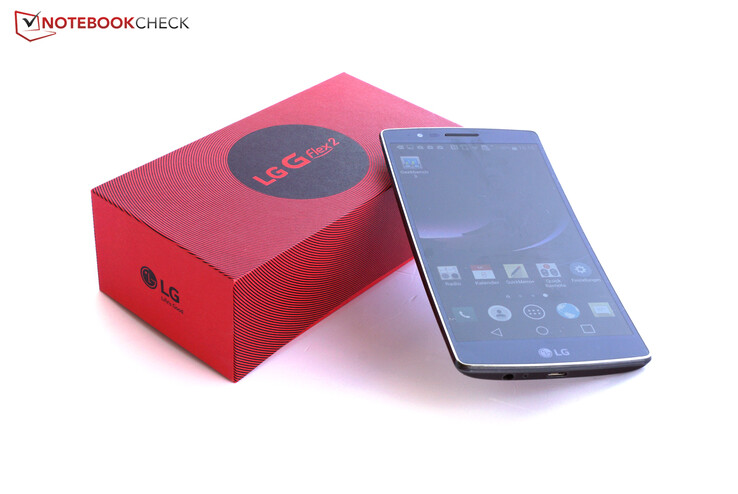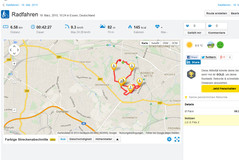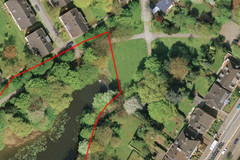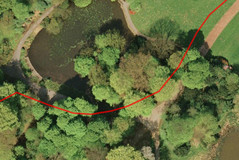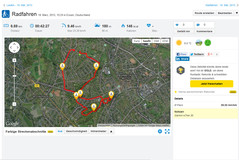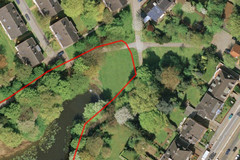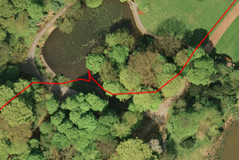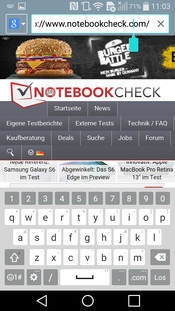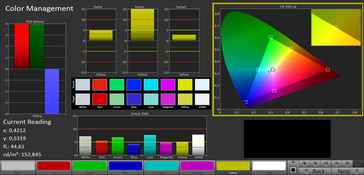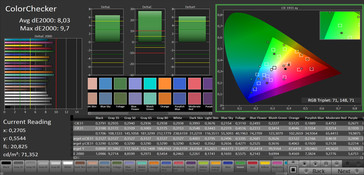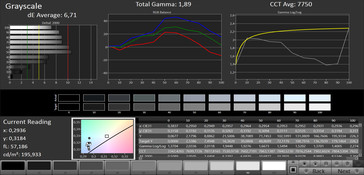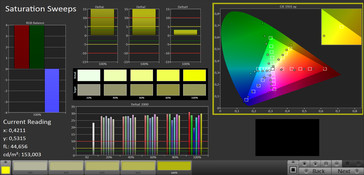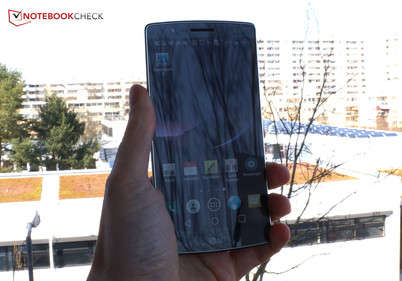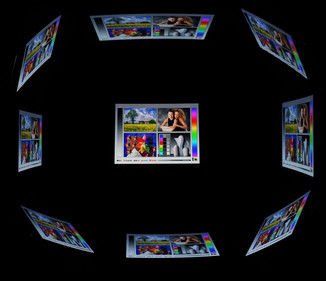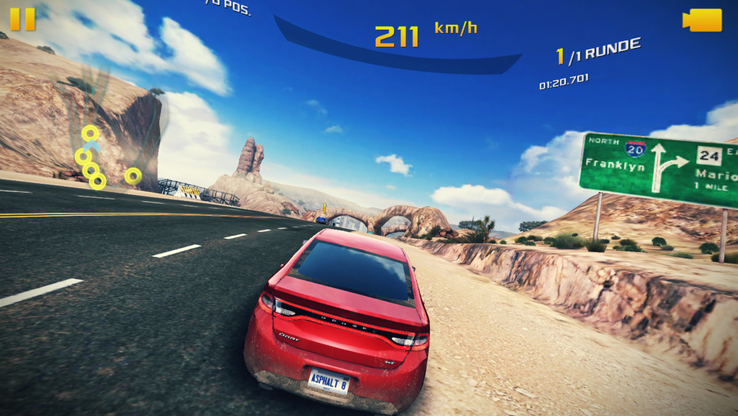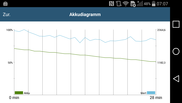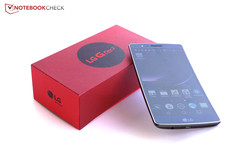LG G Flex 2 Smartphone Review
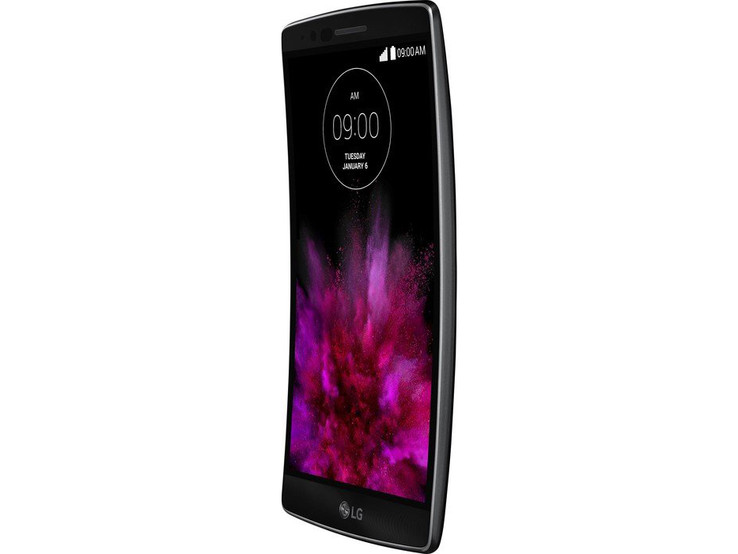
For the original German review, see here.
Currently there are hundreds of smartphones available in the market. Most offer decent performance and look reasonable. This makes it difficult to stand out, but LG managed to do so in early 2014. The curved shape of LG's G Flex in particular, which comfortably nestled on the face during calls, was striking. However, the unusual display technology also had its price and was not free from teething problems, which prevented the G Flex from achieving a higher rating.
LG has now launched the successor into the market: The LG G Flex 2 has shrunk to 5.5 inches, and therefore, can still be called a phablet. The screen resolution is now higher, the processor comes from a newer generation, otherwise, little has changed. Is that enough to compete successfully against the established and significantly cheaper competition?
In the meantime, Google's Nexus 6 and HTC's One M9 have finally been introduced into the market . Add to these, the iPhone 6 Plus or Samsung's Galaxy S6 Edge, which can also score with an unusual display concept. And perhaps even low-priced devices like the OnePlus One might be a threat to LG's G Flex...
Case
Anyone who has ever seen LG's G Flex will immediately recognize the family relationship of the G Flex 2. Once again, the casing curves forward and is flexible. It can be placed on a table and pressed down until it is flat. Although the smartphone produces cracking noises, it reverts to its original shape afterward.
On the one hand, the curved shape pleasantly nestles up against the cheek during calls and on the other, the phone can be carried around comfortably in the pants pocket; it is unlikely that the flexible casing would get damaged.
The phone features the self-healing back cover with a coating of polyrotaxane that closes minor scratches on its own. However, these scratches do not remain invisible; they reappear against the light. It is reassuring that LG has once again decided to equip the screen with Gorilla Glass 3, which makes it more scratch resistant.
However, we do not find the curved casing entirely practical. The position of the standby button and volume control on the back often make it necessary to change one's grip before they are in reach. Keys on the sides are quicker to access.
Pressure on the screen is not visible, and the casing can hardly be twisted. Although the smartphone is relatively flexible, the casing seems quite stable at the same time.
The G Flex 2 is smaller than its precursor; the screen measures only 5.5 inches diagonally. The casing's dimensions are 9.4 x 149.1 x 75.3 millimeters (~0.37 x 5.9 x 3 in) and thus its depth and width have shrunk, but it is also slightly thicker.
Connectivity
LG has reduced the internal storage from 32 to 16 GB. The system reserves 8 GB of that for itself. However, LG's G Flex 2 supports micro-SD memory cards with up to 2 TB, which should certainly suffice in the future. Presently, memory cards have a maximum of 128 GB. The micro-SD card and micro-SIM can be inserted into a combined reader under the removable back cover, but the battery cannot be swapped.
This time, LG has not installed a USB 3.0 port, but the micro-USB 2.0 port in LG's G Flex 2 supports SlimPort technology for transmitting video and audio signals via the USB port. Other available transmission technologies are Miracast, Android Beam, SmartShare Beam, and DLNA. Furthermore, an FM radio is also installed.
The working memory of 2 GB is still generously sized as befits a high-end device. An Infrared transmitter is also located on the casing's upper edge. It enables using the smartphone as a remote control for the TV, for example.
Software
LG's proprietary software, Fluid UI is based on Android Lollipop 5. This is good news, because several manufacturers have not yet changed to Google's latest operating system. On the Internet, many users have complained that the Fluid UI is not one of the fastest user interfaces and that it occasionally takes time to reload. We have also observed this behavior during our tests now and again.
LG has incorporated some special features in its software. For example, it is possible to flick downward on the lock screen to display notifications and the time without having to activate the smartphone. "Knock Code" enables creating a personal tap code for unlocking the smartphone, bypassing the awkwardly positioned standby button on the back. This works quite reliably. Two applications can be activated beside each other on the split screen, or single apps can be displayed over the user interfaces as a floating window.
Fortunately, no adware has been installed. Instead, some very useful apps are preloaded that can be uninstalled should they not be wanted: A to-do list can be created, TVs can be controlled via "Quick Remote", or the smartphone can be controlled via "Voice Mate".
Communication & GPS
Not much has changed in the wireless communication standards compared with the precursor. This was not necessary for Wi-Fi: All current standards up to the very fast 802.11 ac are supported. The reception was still decent at a distance of 10 meters (~33 ft) and through three walls. However, the smartphone often had minor communication issues with our Wi-Fi network, which were evident in the slow opening of websites. NFC and Bluetooth 4.1 are also installed.
Four frequencies are supported in the GSM network, as well as the UMTS and the LTE networks. This is rather meager for a high-end smartphone. Globetrotters might not find a signal in some regions. The reception was good in the urban area in the moderately developed German E-Plus net; even in the indoors we often had full signal.
The GPS module could not track us indoors and needed a relatively long time before it located us in the outdoors, with an accuracy of about 10 meters (~33 ft). We take both the Garmin eTrex 30 and the smartphone on a bike ride for a direct comparison. LG's G Flex 2 measured 110 meters (~120 yd) less than the navigation system, which is a significant deviation considering the fairly short route. The altitude deviations are significantly high, where the review sample measured 100 meters (~109 yd) less than the navigation system. Neither device is perfect in tracking on paths and streets. For example, both showed us "hovering" over a pond rather than placing us on the path. Garmin's navigation system is significantly more accurate at the junction.
Telephone & Voice Quality
LG has modified the phone app slightly, which can also be displayed as a floating window over the rest of the operating system. Otherwise, Android veterans and even newcomers will quickly get used to it. The app with the tabs "Dial", "Call Lists", "Contacts", "Favorites" and "Groups" should be self-explanatory. Users, who find the screen too big, can also enable one-handed control, which displays a smaller keypad on the right edge of the screen.
The voice quality is good; the other party was sufficiently loud and quite clear. Thanks to the decent microphone, our voice was also clear at the other end. In hands-free mode, the call partners also understood each other well. The reason that the call quality cannot quite match that of, for example, the excellent Sony Xperia Z3 is because somewhat louder voices cause the speaker to hum at the other end, and the microphone adds some static noise to our voice when listening closely.
Cameras & Multimedia
LG has quite a good proprietary camera technology that has already been installed in the LG G3. A 13-megapixel camera with a maximum resolution of 4160x3120 pixels, an optical image stabilizer that is particularly practical when recording videos and a laser auto-focus system is located on the back. In addition, there is a face recognition algorithm and a conventional auto-focus since according to some sources, the laser has a relatively short range. In fact, focusing was quite fast in our test even when the object was at a distance.
The image quality is very appealing with good colors and image sharpness; the surfaces look a little grainy when magnified. The cameras in LG's G Flex 2 and Samsung's Galaxy S6 Edge are roughly on par in bright light. The dual LED flash helps in low light. Even without it, the G Flex 2 takes relatively decent pictures, although edges and surfaces look patchy. Compared with other smartphones, low-light pictures are quite focused.
Selfies taken with the front-facing camera also look sharp, but again, they look pixelated and large areas look patchy when zoomed in. However, this is not a bad performance for a secondary camera. It is a little annoying that LG's G Flex 2 does not have a dedicated camera button. The rear-sided buttons are just passably suitable for a release button since they are placed quite close to the camera lens.
The G Flex 2 can record UHD videos in 4K resolution. However, LG does not specify any frame rates. We measured 30 frames per second, but panning and fast movements do not look very smooth. The lens adapts quickly to brightness changes, but color areas look patchy, the colors are pale, and diagonal lines in the pictures are not displayed properly. It does not have a real "Wow - 4K!" factor.
Accessories
A headset is included with the LG G Flex 2. We will deal with its audio quality under "Speakers". Otherwise, a small charger with a separate USB cable and a not very helpful quick start guide is in the box. Device specific accessories for the G Flex 2 are not found on LG's homepage.
Warranty
A 24-month warranty is included with the smartphone.
Input Devices & Controls
LG's keyboard is convenient to use; its height and layout can be customized and the language is quickly changed via the settings button. It was rather annoying that although German was set from the beginning, an English keyboard layout was displayed and the umlauts were not found directly on the keyboard even in the German layout.
The touchscreen is very sensitive; it responds to light touch and is reliable even at its edges. The curved shape is rather inconvenient when the smartphone is on a table because the upper and lower parts teeter.
Display
The screen of LG's G Flex was one of the main reasons for complaint. Although the specially developed plastic OLED screen reproduced absolute black and brilliant colors, it should have at least had a Full HD resolution and been somewhat brighter for its price of 800 Euros (~$852). LG has listened to the criticism about the resolution and now offers Full HD. Since LG's G Flex 2 is rather smaller now, the pixel density has increased to 403 ppi. On the other hand, the brightness rates have dropped, which is too bad. The average brightness is only 273 cd/m². The illumination with a homogeneity of 97% is again outstanding.
| |||||||||||||||||||||||||
Brightness Distribution: 97 %
Center on Battery: 278 cd/m²
Contrast: ∞:1 (Black: 0 cd/m²)
ΔE Color 8.03 | 0.5-29.43 Ø5
ΔE Greyscale 6.71 | 0.57-98 Ø5.3
Gamma: 1.89
| LG G Flex 2 Adreno 430, 810 MSM8994, 16 GB eMMC Flash | Apple iPhone 6 Plus PowerVR GX6450, A8, 64 GB eMMC Flash | Google Nexus 6 Adreno 420, 805 APQ8084, 32 GB eMMC Flash | Samsung Galaxy S6 Edge Mali-T760 MP8, Exynos 7420, 32 GB UFS 2.0 Flash | OnePlus One Adreno 330, 801 MSM8974AC, 64 GB eMMC Flash | HTC One M9 Adreno 430, 810 MSM8994, 32 GB eMMC Flash | |
|---|---|---|---|---|---|---|
| Screen | 52% | 8% | 36% | 21% | 30% | |
| Brightness middle | 278 | 519 87% | 274 -1% | 343 23% | 423 52% | 474 71% |
| Brightness | 274 | 496 81% | 264 -4% | 338 23% | 408 49% | 458 67% |
| Brightness Distribution | 97 | 90 -7% | 89 -8% | 94 -3% | 83 -14% | 85 -12% |
| Black Level * | 0.62 | 0.54 | 0.4 | |||
| Colorchecker dE 2000 * | 8.03 | 3.67 54% | 6.99 13% | 2.2 73% | 5.56 31% | 6.32 21% |
| Greyscale dE 2000 * | 6.71 | 3.78 44% | 4.01 40% | 2.37 65% | 7.55 -13% | 6.36 5% |
| Gamma | 1.89 116% | 2.42 91% | 2.03 108% | 2.41 91% | 2.33 94% | 2.43 91% |
| CCT | 7750 84% | 7327 89% | 6329 103% | 6425 101% | 7624 85% | 8218 79% |
| Contrast | 837 | 783 | 1185 | |||
| Color Space (Percent of AdobeRGB 1998) | 87.77 | 58.81 |
* ... smaller is better
Every pixel lights up on its own in an OLED screen and turned off completely so that the black level achieves 0.0 cd/m² and the contrast is theoretically infinite. Both Samsung's Galaxy S6 Edge and Google's Nexus 6 can boast with that, as well. A closer analysis using the CalMAN software and the spectrophotometer exhibited a light bluish cast and relatively high color shifts from the reference color space.
The color reproduction can be set in three levels according to personal preferences in the settings. The colors are somewhat pale in "Natural" mode, but skin looks more natural. In the "Standard" mode, the colors look slightly more brilliant and it is a good compromise of rich colors and natural hues. Colors are very intense in "Vivid" mode, but the picture might seem slightly oversaturated.
Although the high contrast should permit outdoor use, the screen's low brightness impedes this. Furthermore, the glossy screen limits the use of the smartphone in very bright surroundings.
Performance
The Qualcomm Snapdragon 810 MSM8994 SoC in LG's G Flex 2 has eight cores. In the past, we have found that this is more a marketing ploy than providing a real performance boost. It is the same here: Four cores clocked speedily with 2.0 GHz, but the other four are significantly slower with only 1.5 GHz. In addition, the slower cores are based on an inefficient architecture. However, this core combination also makes it possible to disable the stronger cores when less power is used and thus save energy.
LG's G Flex 2 is roughly on par with the OnePlus One in our processor tests, but both the Apple iPhone 6 Plus and the Samsung Galaxy S6 Edge clearly outperform it.
| Linpack Android / IOS | |
| Single Thread (sort by value) | |
| LG G Flex 2 | |
| Apple iPhone 6 Plus | |
| Samsung Galaxy S6 Edge | |
| OnePlus One | |
| HTC One M9 | |
| Multi Thread (sort by value) | |
| LG G Flex 2 | |
| Apple iPhone 6 Plus | |
| Samsung Galaxy S6 Edge | |
| OnePlus One | |
| HTC One M9 | |
| Geekbench 3 | |
| 32 Bit Single-Core Score (sort by value) | |
| LG G Flex 2 | |
| Apple iPhone 6 Plus | |
| Google Nexus 6 | |
| Samsung Galaxy S6 Edge | |
| OnePlus One | |
| HTC One M9 | |
| 32 Bit Multi-Core Score (sort by value) | |
| LG G Flex 2 | |
| Apple iPhone 6 Plus | |
| Google Nexus 6 | |
| Samsung Galaxy S6 Edge | |
| OnePlus One | |
| HTC One M9 | |
| AndEBench | |
| Java (sort by value) | |
| LG G Flex 2 | |
| Samsung Galaxy S6 Edge | |
| HTC One M9 | |
| Native (sort by value) | |
| LG G Flex 2 | |
| Samsung Galaxy S6 Edge | |
| HTC One M9 | |
The Adreno 430 is a very speedy graphics unit with a clock rate of 650 MHz and is only outclassed by the PowerVR GX6450 in Apple's iPhone 6 Plus. We will ascertain whether the graphics card throttles under "Temperature". All other smartphones are clearly surpassed in some parts. The 3D performance should also be enough for demanding mobile games.
| 3DMark | |
| 1280x720 offscreen Ice Storm Unlimited Score (sort by value) | |
| LG G Flex 2 | |
| Apple iPhone 6 Plus | |
| Google Nexus 6 | |
| Samsung Galaxy S6 Edge | |
| OnePlus One | |
| HTC One M9 | |
| 1280x720 offscreen Ice Storm Unlimited Graphics Score (sort by value) | |
| LG G Flex 2 | |
| Apple iPhone 6 Plus | |
| Google Nexus 6 | |
| Samsung Galaxy S6 Edge | |
| OnePlus One | |
| HTC One M9 | |
| 1280x720 offscreen Ice Storm Unlimited Physics (sort by value) | |
| LG G Flex 2 | |
| Apple iPhone 6 Plus | |
| Google Nexus 6 | |
| Samsung Galaxy S6 Edge | |
| OnePlus One | |
| HTC One M9 | |
| GFXBench (DX / GLBenchmark) 2.7 | |
| T-Rex Onscreen (sort by value) | |
| LG G Flex 2 | |
| Apple iPhone 6 Plus | |
| Google Nexus 6 | |
| Samsung Galaxy S6 Edge | |
| OnePlus One | |
| HTC One M9 | |
| 1920x1080 T-Rex Offscreen (sort by value) | |
| LG G Flex 2 | |
| Apple iPhone 6 Plus | |
| Google Nexus 6 | |
| Samsung Galaxy S6 Edge | |
| OnePlus One | |
| HTC One M9 | |
| GFXBench 3.0 | |
| on screen Manhattan Onscreen OGL (sort by value) | |
| LG G Flex 2 | |
| Apple iPhone 6 Plus | |
| Google Nexus 6 | |
| Samsung Galaxy S6 Edge | |
| OnePlus One | |
| HTC One M9 | |
| 1920x1080 1080p Manhattan Offscreen (sort by value) | |
| LG G Flex 2 | |
| Apple iPhone 6 Plus | |
| Google Nexus 6 | |
| Samsung Galaxy S6 Edge | |
| OnePlus One | |
| HTC One M9 | |
| GFXBench 3.1 | |
| on screen Manhattan ES 3.1 Onscreen (sort by value) | |
| LG G Flex 2 | |
| Samsung Galaxy S6 Edge | |
| HTC One M9 | |
| 1920x1080 Manhattan ES 3.1 Offscreen (sort by value) | |
| LG G Flex 2 | |
| Samsung Galaxy S6 Edge | |
| HTC One M9 | |
| Basemark ES 3.1 / Metal - offscreen Overall Score (sort by value) | |
| LG G Flex 2 | |
| HTC One M9 | |
| Basemark X 1.1 | |
| Medium Quality (sort by value) | |
| LG G Flex 2 | |
| Samsung Galaxy S6 Edge | |
| OnePlus One | |
| HTC One M9 | |
| High Quality (sort by value) | |
| LG G Flex 2 | |
| Samsung Galaxy S6 Edge | |
| OnePlus One | |
| HTC One M9 | |
| Epic Citadel | |
| High Performance (sort by value) | |
| LG G Flex 2 | |
| OnePlus One | |
| High Quality (sort by value) | |
| LG G Flex 2 | |
| OnePlus One | |
| Ultra High Quality (sort by value) | |
| LG G Flex 2 | |
| Samsung Galaxy S6 Edge | |
| OnePlus One | |
| HTC One M9 | |
Internet browsing is certainly one of the strengths of LG's G Flex 2. Websites are opened very quickly and there are no speed problems with animations that are based on web technologies.
| Sunspider - 1.0 Total Score (sort by value) | |
| LG G Flex 2 | |
| Apple iPhone 6 Plus | |
| Google Nexus 6 | |
| Samsung Galaxy S6 Edge | |
| OnePlus One | |
| HTC One M9 | |
| Google V8 Ver. 7 - Google V8 Ver. 7 Score (sort by value) | |
| LG G Flex 2 | |
| Apple iPhone 6 Plus | |
| Google Nexus 6 | |
| Samsung Galaxy S6 Edge | |
| OnePlus One | |
| HTC One M9 | |
| Octane V2 - Total Score (sort by value) | |
| LG G Flex 2 | |
| Apple iPhone 6 Plus | |
| Google Nexus 6 | |
| Samsung Galaxy S6 Edge | |
| HTC One M9 | |
| Peacekeeper - --- (sort by value) | |
| LG G Flex 2 | |
| Apple iPhone 6 Plus | |
| Samsung Galaxy S6 Edge | |
| OnePlus One | |
| HTC One M9 | |
* ... smaller is better
The storage is not quite as fast as in Samsung's Galaxy S6 Edge, but it is still faster than all other Android comparison devices. The read speeds are particularly impressive, and thus it is rather surprising that loading occasionally takes quite some time. More about this can be read under "Games".
| AndroBench 3-5 | |
| Sequential Read 256KB (sort by value) | |
| LG G Flex 2 | |
| Google Nexus 6 | |
| Samsung Galaxy S6 Edge | |
| OnePlus One | |
| HTC One M9 | |
| Sequential Write 256KB (sort by value) | |
| LG G Flex 2 | |
| Google Nexus 6 | |
| Samsung Galaxy S6 Edge | |
| OnePlus One | |
| HTC One M9 | |
| Random Read 4KB (sort by value) | |
| LG G Flex 2 | |
| Google Nexus 6 | |
| Samsung Galaxy S6 Edge | |
| OnePlus One | |
| HTC One M9 | |
| Random Write 4KB (sort by value) | |
| LG G Flex 2 | |
| Google Nexus 6 | |
| Samsung Galaxy S6 Edge | |
| OnePlus One | |
| HTC One M9 | |
Games
We tested the gaming performance with the graphically demanding racing game “Asphalt 8”. The relatively long loading times that LG's G Flex 2 needed struck us right away. While micro-stutters were noticed in the intro sequence, everything ran relatively smoothly during the race itself in both medium and high details. More basic games like “Angry Birds” will be playable without any problems.
Emissions
Temperature
The temperature development is almost identical to that of the precursor. LG's G Flex 2 reaches an absolute maximum of 40.2 degrees Celsius (~104 °F). The maximum temperature of 30.2 degrees Celsius (~86 °F) is reached while idling. Thus, the review sample's overall temperature increase is lightly palpable but never unpleasant.
We check whether the full performance can be retrieved via the battery test of GFXBenchmark. The graphs show quite clearly that the performance decreases gradually. For example, over time, the processor's full Turbo clock is not achieved, and some cores are even completely disabled. The GPU also throttles after prolonged load, which explains the lower benchmark results.
(±) The maximum temperature on the upper side is 40.2 °C / 104 F, compared to the average of 35 °C / 95 F, ranging from 21.9 to 56 °C for the class Smartphone.
(+) The bottom heats up to a maximum of 37.7 °C / 100 F, compared to the average of 33.8 °C / 93 F
(+) In idle usage, the average temperature for the upper side is 28.9 °C / 84 F, compared to the device average of 32.7 °C / 91 F.
Speakers
The speaker is still rather average. Although the maximum volume is not bad and the sound does not distort at the maximum setting, there are hardly any bass and the mids are quite weak. Trebles and sibilants are often unpleasantly emphasized. Since the speaker is on the rear, the sound might muffle when the smartphone is placed on a soft surface or a finger accidentally covers the speaker.
In that case, the decent sounding in-ear headphone "QuadBeat 2" that LG includes should be used. Although a few more deep tones would not have hurt, it does not sound bad for an included headset. The 3.5 mm jack allows users to connect their own headphone to enjoy a good sound.
Energy Management
Power Consumption
LG's G Flex 2 features a quick-charge function. The battery is allegedly charged at fifty percent within half an hour. Unfortunately, we could not check this because the included power supply was faulty. However, we achieved 34% after half an hour using a slightly weaker replacement PSU, which is not a bad rate.
The G Flex 2 does not exactly stand out with energy saving when depleting the battery. The smartphone's power consumption is not measurable when the phone is off and only 0.1 watts are consumed in standby. However, LG's G Flex 2 belongs to the most energy devouring devices in the comparison with a minimum consumption of 1.4 while idling. Its maximum idle consumption is as high as 3.1 watts, which is a very high rate. However, we should also keep in mind that some comparison devices have a much larger screen. The smartphone consumes a maximum of 8.8 watts.
| Off / Standby | |
| Idle | |
| Load |
|
Battery Runtime
The smaller casing also involves a smaller battery capacity compared with LG's G Flex. The successor now only supplies 11.4 Wh. Compared with the comparison devices, some of which are larger, the battery capacity is not bad, but the battery life of LG's G Flex is rather average. Although an almost 10:41 hour of Wi-Fi browsing is a decent time, it cannot keep up with, for example, OnePlus One. The full load runtimes are also short: It stops after 2:23 hours.
| LG G Flex 2 Adreno 430, 810 MSM8994, 16 GB eMMC Flash | Apple iPhone 6 Plus PowerVR GX6450, A8, 64 GB eMMC Flash | Google Nexus 6 Adreno 420, 805 APQ8084, 32 GB eMMC Flash | Samsung Galaxy S6 Edge Mali-T760 MP8, Exynos 7420, 32 GB UFS 2.0 Flash | OnePlus One Adreno 330, 801 MSM8974AC, 64 GB eMMC Flash | HTC One M9 Adreno 430, 810 MSM8994, 32 GB eMMC Flash | |
|---|---|---|---|---|---|---|
| Battery Runtime | 15% | -8% | 1% | 27% | -15% | |
| Reader / Idle | 1274 | 1436 13% | 1153 -9% | 1349 6% | 1568 23% | 805 -37% |
| H.264 | 724 | 675 -7% | 652 -10% | 417 -42% | 893 23% | 421 -42% |
| WiFi v1.3 | 641 | 534 -17% | 963 50% | 348 -46% | ||
| Load | 143 | 199 39% | 135 -6% | 224 57% | 160 12% | 236 65% |
| WiFi | 777 | 601 | 1126 | 573 |
Pros
Cons
Verdict
Buyers have to pony up quite a bit for the uniqueness of LG's G Flex 2. This was already one of the biggest criticisms of the precursor, and our present review sample clearly lags behind other high-end devices in some points while the price is very self-confident. Of course, bending the smartphone without any damage will impress friends. Owners of the iPhone 6 Plus or the Samsung Galaxy S6 Edge will probably pull the saddest faces - keyword "Bendgate"...
Ideas like the self-healing back cover and laser auto-focus are also very innovative. However, LG's G Flex 2 involves making compromises in other places. For example, the integrated storage of 16 GB is rather tight, other phablets offer higher resolutions and brighter screens, and the rear-sided controls are not always practical.
The device is available at a starting price of 599 Euros (~$638) on the Internet, which is on par with Google's Nexus 6. The price of LG's G Flex 2 still cannot compete with the low-priced OnePlus One.
This is a device for tech geeks who are looking for something out-of-the-ordinary. The second edition of LG's G Flex is still an eye-catcher. However, more practical devices are available for those simply looking for a phablet.
LG G Flex 2
-
04/09/2015 v4(old)
Florian Wimmer


 Deutsch
Deutsch English
English Español
Español Français
Français Italiano
Italiano Nederlands
Nederlands Polski
Polski Português
Português Русский
Русский Türkçe
Türkçe Svenska
Svenska Chinese
Chinese Magyar
Magyar